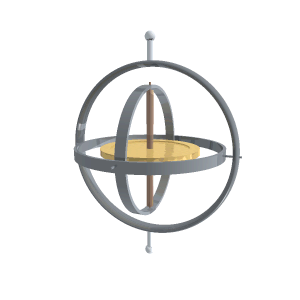Eulerian Angles: Difference between revisions
No edit summary |
|||
| Line 27: | Line 27: | ||
===Simple=== | ===Simple=== | ||
==Connectedness== | ==Connectedness== | ||
#How is this topic connected to something that you are interested in? | #How is this topic connected to something that you are interested in? | ||
All objects in the real world move in complex ways. Luckily for us, we only experience 3 dimensions. Hence, we can use the Eulerian Angles to classify all sorts of rotational behaviors. Knowing how much angular velocity an object has in any direction can give us its position at any time. | |||
#How is it connected to your major? | #How is it connected to your major? | ||
This is | This topic is vastly connected to any major related to engineering mechanics. Mechanical engineering students and aerospace students will find this to be one of the fundamental building blocks of their field of study, as it is an important tool for engineers working in 3 dimensions. Imagine trying to position a satellite in space but not being able to determine where it's facing at a given time! Even video game creators and animators require Eulerian angles for mouse control and orienting animated objects (links below). | ||
===Further reading=== | ===Further reading=== | ||
Euler Angles in Video Games | |||
[https://www.youtube.com/watch?v=zZM2uUkEoFw Mouse Control] | |||
Euler Angles Related Examples | |||
[http://www.chrobotics.com/library/understanding-euler-angles CHRO Robotics] | |||
= | Euler Angles for Animations | ||
[https://www.youtube.com/watch?v=zc8b2Jo7mno Euler (Gimbal lock) Explained] | |||
==References== | ==References== | ||
Dr. Wayne Whiteman | Dr. Wayne Whiteman | ||
DEFINE THE PROPERTIES OF ANGULAR VELOCITY FOR 3D MOTION | DEFINE THE PROPERTIES OF ANGULAR VELOCITY FOR 3D MOTION | ||
[https://www.coursera.org/learn/motion-and-kinetics/lecture/nkGSe/module-13-eulerian-angles-for-3d-rotational-motion Coursera Lesson on Eulerian Angles] | |||
McGill, David J., and Wilton W. King. <i>An Introduction to Dynamics</i>. Monterey, CA: Brooks/Cole Engineering Division, 1984. Print. | |||
Revision as of 00:44, 8 December 2015
Introduction
When you have a body that rotates in plane motion (2-D), it is easy to find the orientation of the body if you have the angular velocity as a function of time. You can integrate this value to find the orientation of the body at any position. In the image shown, we can find out the position of an object at any place in the xy plane.
Unfortunately, you cannot integrate an angular velocity vector with 3-D components to get the orientation of the body in three dimensional space. This requires the concept of Eulerian Angles, which are used in determining a body's orientation in space using angular velocity in the x, y, and z axes.
Eulerian Angles
Essentially, to describe the orientation of a body in 3 dimensions we must describe its rotation about three specific axes. In our example shown in the image, we will first rotate our body's reference frame about the k axis (black to blue), then the j axes (blue to green), and finally the k axis again (green to red).

Note, we moved from the black i, j, k axes to the blue i, j, k axes, where the k axis remained the same for both black and blue frames. Then we moved from the blue i, j, k axes to the green i, j, k axes, where the j axis remained the same for both the blue and green frames. Finally, we moved from the green i, j, k axes to the red i, j, k axes, where the k axis remained the same for both the green and the red frames.
Angular Velocity Using the addition theorem (can be further studied at Coursera) we find that the body A with respect to the inertial frame I is defined to be w = θ' k (black/blue axis) + φ' j (blue/green axis) + ψ' k (green/red axis). However, everything here is defined in different frames and we must consolidate our equations into one coordinate system.
Converting Into One Frame
Example of a Gyroscope
We can use the procedure outlined above to describe the orientation of a gyroscope at any time given the components of its angular velocity. An example of a rotation gyroscope is shown in the image.

Simple
Connectedness
- How is this topic connected to something that you are interested in?
All objects in the real world move in complex ways. Luckily for us, we only experience 3 dimensions. Hence, we can use the Eulerian Angles to classify all sorts of rotational behaviors. Knowing how much angular velocity an object has in any direction can give us its position at any time.
- How is it connected to your major?
This topic is vastly connected to any major related to engineering mechanics. Mechanical engineering students and aerospace students will find this to be one of the fundamental building blocks of their field of study, as it is an important tool for engineers working in 3 dimensions. Imagine trying to position a satellite in space but not being able to determine where it's facing at a given time! Even video game creators and animators require Eulerian angles for mouse control and orienting animated objects (links below).
Further reading
Euler Angles in Video Games Mouse Control
Euler Angles Related Examples CHRO Robotics
Euler Angles for Animations Euler (Gimbal lock) Explained
References
Dr. Wayne Whiteman DEFINE THE PROPERTIES OF ANGULAR VELOCITY FOR 3D MOTION Coursera Lesson on Eulerian Angles
McGill, David J., and Wilton W. King. An Introduction to Dynamics. Monterey, CA: Brooks/Cole Engineering Division, 1984. Print.